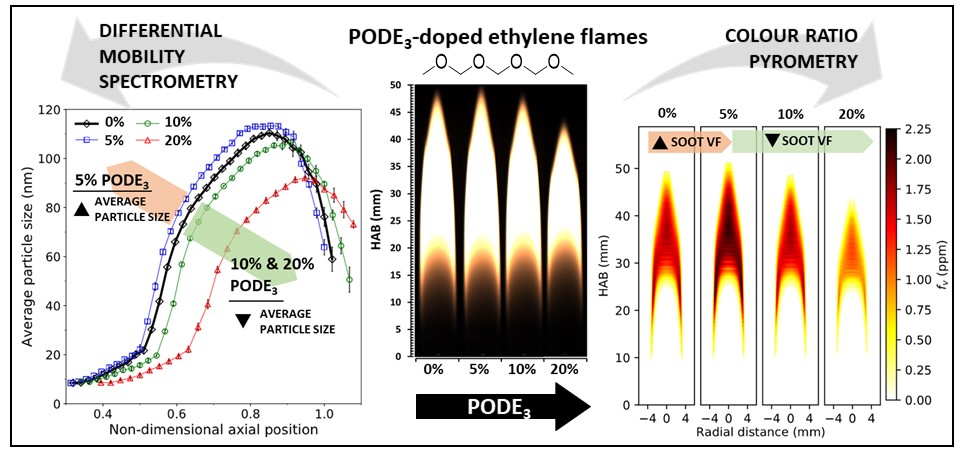Technical Report 255, c4e-Preprint Series, Cambridge
The effect of poly(oxymethylene) dimethyl ethers (PODE3) on soot formation in ethylene/PODE3 laminar coflow diffusion flames
Reference: Technical Report 255, c4e-Preprint Series, Cambridge, 2020
- Soot formation investigated in ethylene/PODE3 laminar diffusion flames
- Increasing PODE3 showed non-monotonic trend in soot volume fraction (SVF)
- SVF and average particle size increased with small addition of PODE3
- Fuel-specific pathways likely contribute to the difference in soot growth
- PSDs for ISF-4 ethylene coflow diffusion flame were reported for the first time
 This paper investigates the effect of poly(oxymethylene) dimethyl ether (PODE3) on soot formation in atmospheric pressure ethylene/PODE3 laminar coflow diffusion flames. The flames were fuelled using ethylene/PODE3 mixtures, where up to 20% of the total carbon in the mixture was substituted with PODE3. Flame temperature measurements suggest that differences in the soot formation in the flames are more likely due to a chemical effect rather than a temperature effect. Colour ratio pyrometry and differential mobility spectrometry were used to measure the soot volume fraction (SVF) and the particle size distribution (PSD) of the flames. PODE3 was observed to be effective in reducing soot formation due to its high oxygen content and the absence of carbon-carbon bonds as per previous engine studies. However, for the laboratory flames studied in this work, it was observed that introducing low levels of PODE3 actually increased the amount of soot. When PODE3 was blended with ethylene at 5%, there was an increase of about 10% in the SVF and about 6% in average particle size compared to the pure ethylene flame. Consideration of the chemical pathways suggests that this interaction is specific to C2 chemistry. Only when the amount of PODE3 was increased to 10% did the SVF decrease. A further increase in PODE3 to 20% was observed to inhibit the particle growth, with the maximum average particle size decreasing by about 73%. The results suggest that blending sufficient amounts of PODE3 with fuels could reduce soot formation, but that the use of too little PODE3 could increase soot formation in the cases of fuels that produce a substantial amount of C2 species in fuel-rich regions of an engine. The data set reported with this paper includes, for the first time, PSD data for the International Sooting Flame Workshop coflow laminar diffusion flame (ISF-4 coflow 3).
This paper investigates the effect of poly(oxymethylene) dimethyl ether (PODE3) on soot formation in atmospheric pressure ethylene/PODE3 laminar coflow diffusion flames. The flames were fuelled using ethylene/PODE3 mixtures, where up to 20% of the total carbon in the mixture was substituted with PODE3. Flame temperature measurements suggest that differences in the soot formation in the flames are more likely due to a chemical effect rather than a temperature effect. Colour ratio pyrometry and differential mobility spectrometry were used to measure the soot volume fraction (SVF) and the particle size distribution (PSD) of the flames. PODE3 was observed to be effective in reducing soot formation due to its high oxygen content and the absence of carbon-carbon bonds as per previous engine studies. However, for the laboratory flames studied in this work, it was observed that introducing low levels of PODE3 actually increased the amount of soot. When PODE3 was blended with ethylene at 5%, there was an increase of about 10% in the SVF and about 6% in average particle size compared to the pure ethylene flame. Consideration of the chemical pathways suggests that this interaction is specific to C2 chemistry. Only when the amount of PODE3 was increased to 10% did the SVF decrease. A further increase in PODE3 to 20% was observed to inhibit the particle growth, with the maximum average particle size decreasing by about 73%. The results suggest that blending sufficient amounts of PODE3 with fuels could reduce soot formation, but that the use of too little PODE3 could increase soot formation in the cases of fuels that produce a substantial amount of C2 species in fuel-rich regions of an engine. The data set reported with this paper includes, for the first time, PSD data for the International Sooting Flame Workshop coflow laminar diffusion flame (ISF-4 coflow 3).
Material from this preprint has been published in Fuel.
PDF (3.0 MB)



